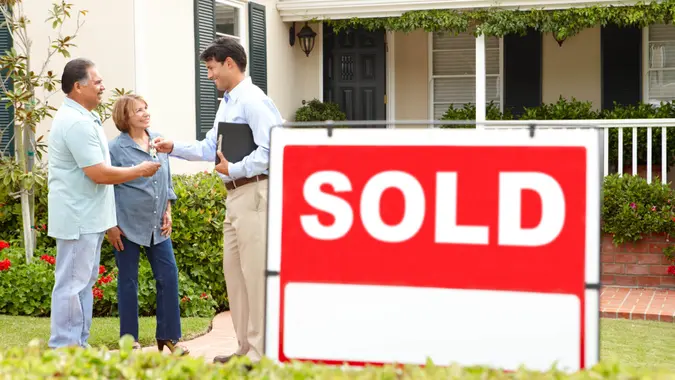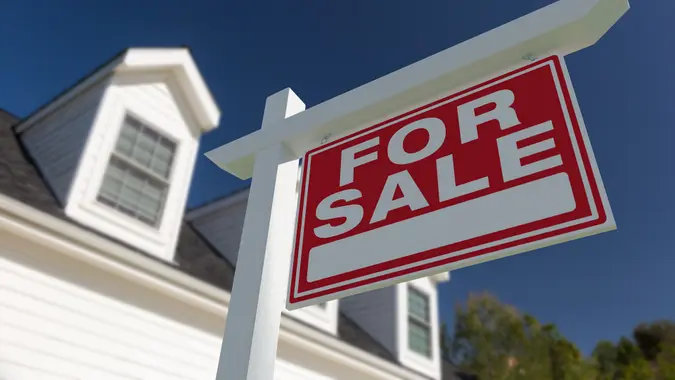How To Pay Off Your Mortgage in 10 Years

Commitment to Our Readers
GOBankingRates' editorial team is committed to bringing you unbiased reviews and information. We use data-driven methodologies to evaluate financial products and services - our reviews and ratings are not influenced by advertisers. You can read more about our editorial guidelines and our products and services review methodology.

20 Years
Helping You Live Richer

Reviewed
by Experts

Trusted by
Millions of Readers
With mortgage interest rates at historical lows in recent months, homes are flying off the market and millions of Americans are becoming first-time homeowners. For most, their home will be the most valuable asset in their total net worth, but while a home is generally a sound and smart investment, those mortgage payments can be a cumbrous liability. Unaffordable mortgages and foreclosures can lead to bankruptcy.
Most lenders offer, at minimum, a 15-year mortgage, though the most popular option is a 30-year loan. Those who’d like to cut that timeframe down, and pay the mortgage off in only 10 years, should consider making the following expert moves.
Get the Right Mortgage
If you’ve yet to own a home but are about to lay down an anchor with the goal of paying your mortgage down in 10 years, your first step should be to obtain the shortest term you can find, which in most cases is going to be 15 years.
“Don’t worry about discount points,” said Ann Martin, director of operations at CreditDonkey. “You’ll be paying extra each month anyway, meaning that you won’t get the full benefit of the point since you won’t be dealing with the full life of the loan. Once you’ve got a short-term, low-interest mortgage locked in, the next step is to monetize your home as much as possible. Take full advantage of any tax deductions, energy efficiency credits, and other programs available in some cities and states that will reimburse you for certain repairs and renovations.”
Get a 30-Year Mortgage — With Investment in Mind
“Get a 30-year mortgage and invest the difference between a 30-year mortgage and a 10-year mortgage,” said Khari Washington, broker and owner of 1st United Realty & Mortgage. “The stock market averages a higher return than the interest rate on a mortgage. A homeowner could invest the difference between a 30-year payment and a 10-year payment into the market and then take the invested amount and pay off the loan at the end of the 10th year.”
Build a Budget Around Your Goal
“A budget can help a homeowner understand exactly how much he or she can afford in home payments every month,” said David Frederick, director of client success and advice at First Bank. “If the homeowner can afford to do so, it may be worthwhile to accelerate the mortgage pay-down by making recurring payments larger than the required monthly mortgage payment. In such a case, the homeowner can make extra principal payments on the mortgage each month as long as he or she sticks to the budget.”
Refinance the Mortgage (Consider a 15-Year Loan)
If it turns out that you can make heftier payments than required, you should look into refinancing the mortgage into a shorter term.
“Shorter term mortgages will have higher monthly payments but will also likely have lower interest rates,” Frederick said, “Refinancing into a 10-year term may be a stretch for most homeowners but doing so essentially compels the homeowner to pay off the mortgage in 10 years and likely comes with some of the lowest possible interest rates in the market. For a little bit of breathing room, homeowners who want to pay off the mortgage in 10 years should consider pursuing a 15-year loan and make extra monthly payments.”
Frederick added that the 15-year loan may have a higher interest rate than a 10-year mortgage, but it’s likely to have a significantly lower interest rate than a 30-year loan and with a lower monthly payment than required by a 10-year loan.
Tips:
Make Larger Monthly Payments
“The easiest and fastest way to pay down your mortgage is faster is larger monthly payments and extra money towards principal when available,” said Ralph DiBugnara, president of Home Qualified and SVP at Cardinal Financial. “A 10-year payment compared to a 30-year payment is going to cost a homeowner about $575 dollars extra a month per $100,000 borrowed. That $575 per $100,000 would need to be added to your principal payment monthly.”
Drudging up extra money to pay down your mortgage can prove a difficult task. Another similar approach is to take any large sums of money received and apply them to the principal.
“This can come in the form of a tax refund, bonus from work, salary increase or overtime earned,” DiBugnara said. “For every extra payment a year you make on a mortgage you can save between five and seven years. So three to four extra payments a year will get you to the 10 year mark for a payoff.”
Helpful:
Pay Biweekly
“One of the best ways to pay off your mortgage early is by paying biweekly,” said Chris Allard, Ottawa mortgage broker. “Biweekly payments, which require paying half of your monthly payment every two weeks, result in a total of 26 half-payments in a given year. Instead of making 12 full mortgage payments in a year if you are on a monthly payment plan, you end up making 13 full payments on a biweekly plan, without feeling like the additional payment is a huge burden.”
Recast
“Mortgage bankers have their own interest rates and products available, which will be set for a certain time period,” said Natasha Furness, business operations manager at Right Mortgage UK. “You may be able to move to different products to make sure you’re getting the best deal. Reach out to your loan officer to see if you’re on the right track, or if there’s anything you can change. The higher the interest rate, the more your payments will be, and the longer it will take to pay your mortgage off. Of course, the lower the interest rate, the quicker you will pay it down.”
Use Mortgage Points
“Using Mortgage points, also known as loan origination points or discount points, you can pay off your mortgage in 10 years,” said Rodrigo Gonzalez, a real estate investor. “These are fees that a borrower pays to a lender in order to get a lower interest rate on a mortgage. Each point is equal to 1% of the mortgage amount. For example, if you’re taking out a $200,000 mortgage and you pay two points, you’ll be paying $4,000. In exchange for these points, however, your lender will give you a lower interest rate on your mortgage. This can save you money over the life of your loan.”
More From GOBankingRates
 Written by
Written by  Edited by
Edited by 

























